Main menu
Common skin conditions

NEWS
Join DermNet PRO
Read more
Quick links
Topical steroid — extra information
Topical steroid
Author: Dr Amanda Oakley, Dermatologist, Hamilton, New Zealand, 1997. Updated 4 January 2016.
Introduction
How it works
Different potencies
Formulations
New Zealand preparations
Side effects
How to use
Bans in cosmetic products
What is a topical steroid?
A topical steroid is an anti-inflammatory preparation used to control eczema/dermatitis and many other skin conditions. Topical steroids are available in creams, ointments, solutions and other vehicles.
Topical steroids are also called topical corticosteroids, glucocorticosteroids, and cortisone.
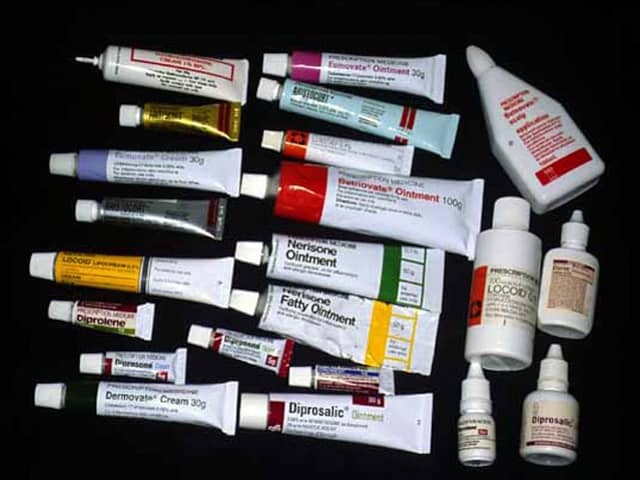
Topical steroids in differing vehicles
How does a topical steroid work?
The effects of topical steroid on various cells in the skin are:
- Anti-inflammatory
- Immunosuppressive
- Anti-proliferative
- Vasoconstrictive.
The potency of topical steroid
The potency of a topical steroid depends on:
- The specific molecule
- The amount that reaches the target cell
- Absorption through the skin (0.25%–3%)
- Formulation.
There is little point in diluting a topical steroid, as their potency does not depend much on concentration and diluting the product does not reduce the risk of adverse effects. After the first 2 or 3 applications, there is no additional benefit from applying a topical steroid more than once daily.
A topical steroid is absorbed in different rates depending on skin thickness.
- The greatest absorption occurs through the thin skin of eyelids, genitals, and skin creases when a potent topical steroid is best avoided.
- The least absorption occurs through the thick skin of palms and soles, where a mild topical steroid is ineffective.
Absorption also depends on the vehicle in which the topical steroid is delivered and is greatly enhanced by occlusion.
Formulations of topical steroid
Several formulations are available for topical steroids, intended to suit the type of skin lesion and its location. Creams and lotions are general purpose and are the most popular formulations.
Ointment
- The most suitable formulation for dry, non-hairy skin
- No requirement for preservative, reducing risk of irritancy and contact allergy
- Occlusive, increasing risk of folliculitis and miliaria
Gel or solution
- Useful in hair-bearing skin
- Has an astringent (drying) effect
- Stings inflamed skin
- Self-adhesive plastic tapes
- Contain corticosteroid, often fludroxycortide, in the adhesive
- Not available in all countries
As a general rule, use the weakest possible steroid that will do the job. It is often appropriate to use a potent preparation for a short time to ensure the skin condition clears completely.
Combination products
Topical steroid is sometimes combined with another active ingredient, including antibacterial, antifungal agent or calcipotriol. Topical corticosteroid/antibiotic preparations should be used rarely, and short-term (eg, three times daily for one week for a small area of infected dermatitis), to reduce the risk of antimicrobial resistance.
Which topical steroids are available in New Zealand?
Topical steroids are medicines regulated by Health Authorities. They are classified according to their strength. The products listed here are those available in New Zealand in November 2017.
Very potent or superpotent (up to 600 times as potent as hydrocortisone)
- Clobetasol propionate
- Betamethasone dipropionate (in an optimised vehicle)
Potent (100–150 times as potent as hydrocortisone)
- Betamethasone valerate
- Betamethasone dipropionate (cream, ointment, gel)
- Diflucortolone valerate
- Hydrocortisone 17-butyrate
- Mometasone furoate
- Methylprednisolone aceponate
Moderate (2–25 times as potent as hydrocortisone)
- Clobetasone butyrate
- Triamcinolone acetonide
Mild
- Hydrocortisone
- Hydrocortisone acetate
What are the side effects of topical steroid?
Side effects are uncommon or rare when topical steroids are used appropriately under medical supervision. Topical steroid may be falsely blamed for a sign when underlying disease or another condition is responsible (for example, postinflammatory hypopigmentation or undertreated atopic eczema).
Cushing syndrome
Internal side effects similar to those due to systemic steroid (Cushing syndrome) are rarely reported from topical steroids, and only after long-term use of large quantities of topical steroid (eg > 50 g of clobetasol propionate or > 500 g of hydrocortisone per week).
Cases of Cushing syndrome due to topical corticosteroids most often occur because of inappropriate prescribing or over the counter sales of corticosteroids in countries where that is permitted.
Cutaneous side effects
Local side effects may arise when a potent topical steroid is applied daily for long periods of time (months). Most reports of side effects describe prolonged use of an unnecessarily potent topical steroid for inappropriate indications.
- Skin thinning (atrophy)
- Stretch marks (striae) in armpits or groin
- Easy bruising (senile/solar purpura) and tearing of the skin
- Enlarged blood vessels (telangiectasia)
- Localised increased hair thickness and length (hypertrichosis)
A topical steroid can cause, aggravate or mask skin infections such as impetigo, tinea, herpes simplex, malassezia folliculitis and molluscum contagiosum. Note: topical steroid remains the first-line treatment for infected eczema.
A potent topical steroid applied for weeks to months or longer can lead to:
- Periorificial dermatitis (common); this can occur in children
- Steroid rosacea
- Symptoms due to topical corticosteroid withdrawal
- Pustular psoriasis.
Stinging frequently occurs when a topical steroid is first applied, due to underlying inflammation and broken skin. Contact allergy to steroid molecule, preservative or vehicle is uncommon but may occur after the first application of the product or after many years of its use.
Adverse effects of topical steroids
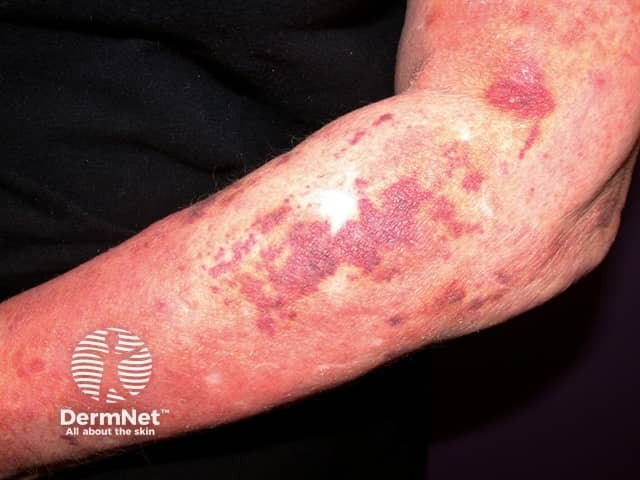
Bruising

Skin thinning
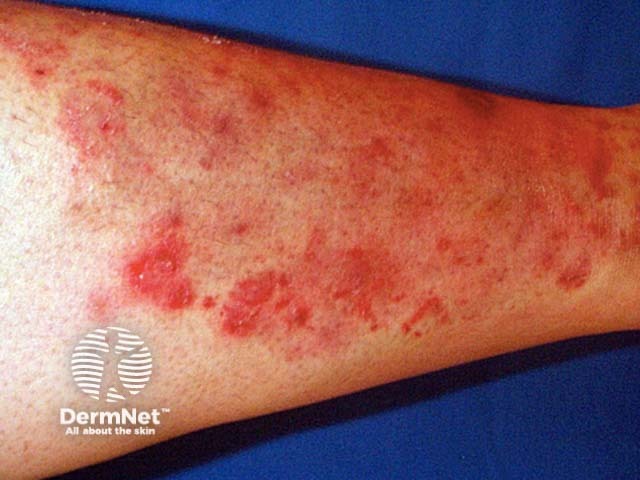
Tinea incognita
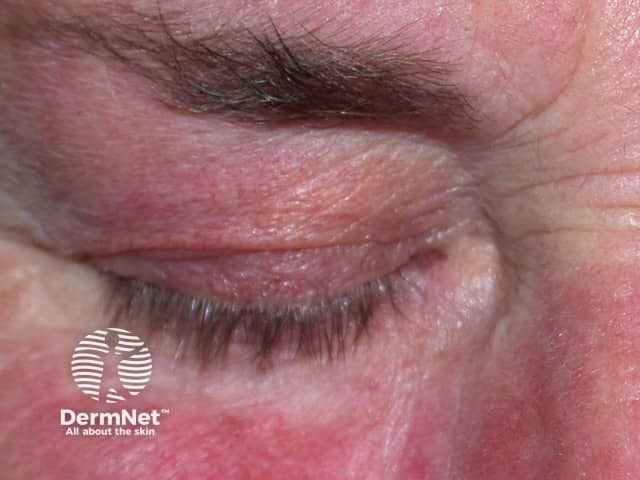
Prominent capillaries
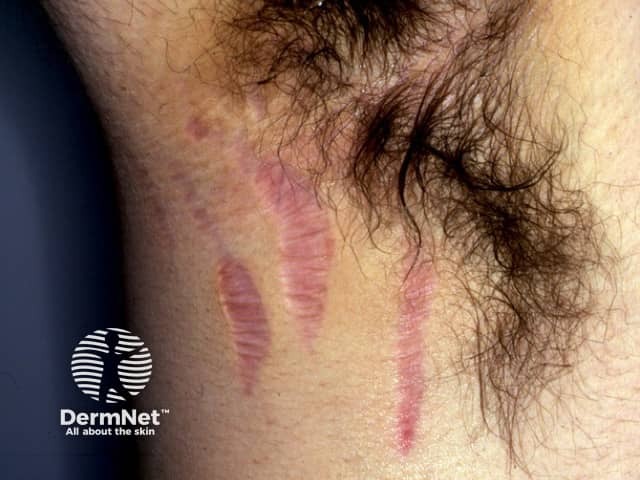
Stretch marks
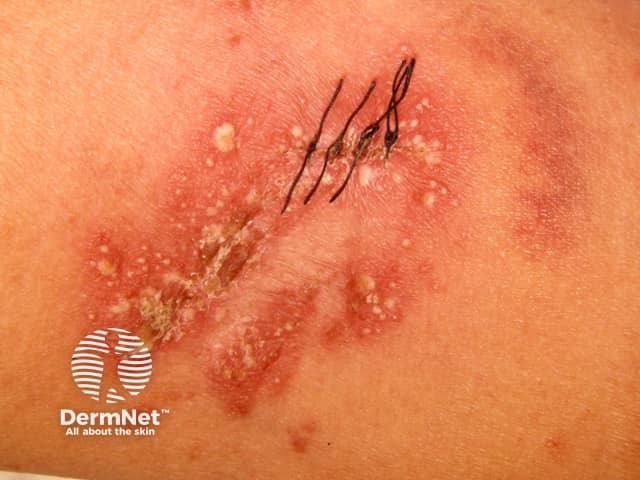
Localised pustular psoriasis
Ocular side effects
A topical steroid should be used cautiously on eyelid skin, where it commonly results in periocular dermatitis. Potentially, excessive use over weeks to months might lead to glaucoma or cataracts.
Topical steroid in pregnancy
Mild and moderate-potency topical steroids can be safely used in pregnancy. Caution should be used for potent and ultrapotent topical steroids used over large areas or under occlusion, of which a proportion will be absorbed systemically.
Reports of low birth-weight infants exposed to high-dose topical steroid are not thought to be due to the medication.
How to use a topical steroid
Topical steroid is applied once daily (usually at night) to inflamed skin for a course of 5 days to several weeks. After that, it is usually stopped, or the strength or frequency of application is reduced.
Emollients can be applied before or after the application of topical steroid, to relieve irritation and dryness or as a barrier preparation. Infection may need additional treatment.
Fingertip unit
The fingertip unit guides the amount of topical steroid to be applied to a body site. One unit describes the amount of cream squeezed out of its tube onto the volar aspect of the terminal phalanx of the index finger.

Fingertip unit
The quantity of cream in a fingertip unit varies with sex, age and body part.
- One arm: apply 3 fingertip units
- One foot: apply 2 fingertip units
- One leg: apply 6 fingertip units
- Face and neck: apply 2.5 fingertip units
- Trunk, front & back: 14 fingertip units
- Entire body: about 40 units
Illegal topical corticosteroid in cosmetic products
Topical corticosteroids are regulated. However, a potent steroid is illegally present in some cosmetic products purchased over the counter or via the Internet, according to reports from China and several developing countries. This has resulted in many reports of steroid-dependent periorificial dermatitis, rosacea and other adverse effects.
Approved datasheets are the official source of information for medicines, including approved uses, doses, and safety information. Check the individual datasheet in your country for information about medicines.
We suggest you refer to your national drug approval agency such as the Australian Therapeutic Goods Administration (TGA), US Food and Drug Administration (FDA), UK Medicines and Healthcare products regulatory agency (MHRA) / emc, and NZ Medsafe, or a national or state-approved formulary eg, the New Zealand Formulary (NZF) and New Zealand Formulary for Children (NZFC) and the British National Formulary (BNF) and British National Formulary for Children (BNFC).
References
- Mooney E, Rademaker M, Dailey R, Daniel BS, et al. Adverse effects of topical corticosteroids in paediatric eczema: Australasian consensus statement. Australas J Dermatol. 2015 Mar 6. doi: 10.1111/ajd.12313. [Epub ahead of print] PubMed PMID: 25752907.
- MIMS Online accessed 22 February 2014
- Can topical steroids be applied at the same time as emollients? Medicines Q&As. NHS
- Corticosteroids (Ch. 25). In: Bolognia JL, Jorizzo JL, Rapini RP, editors. Bolognia Textbook of Dermatology. 2nd ed. Mosby Elsevier publishing; 2008.
- Xie H, Xiao X, Li J. Topical Steroids in Chinese Cosmetics. JAMA Dermatol. 2017;153(9): 855–6. doi:10.1001/jamadermatol.2017.1615. Journal.
- Adrenal Suppression Associated with the Use of Topical Corticosteroids. Medsafe. Prescriber Update 38(4): 52–3. December 2017.
On DermNet
- Systemic steroids
- Intralesional steroids
- Topical corticosteroid contact allergy
- Topical corticosteroid withdrawal
- Allergies explained
- Occupational dermatitis among construction workers
- Occupational skin disorders in homemakers
Other websites
- Topical Corticosteroids Medical Education (UK)
- CorticoCalc Corticocream Calculator — a Mobile app that helps assess potency and quantity of topical steroids
- Consumer medicine information and data sheets – Medsafe
- Drugs, Herbs and Supplements – MedlinePlus
- International Topical Steroid Awareness Network
- The Australasian College of Dermatologists Consensus Statement Topical corticosteroids in paediatric eczema (PDF)
- The Australasian College of Dermatologists Patient Q and A: Topical steroids for the treatment of eczema (PDF)
- The Australasian College of Dermatologists Patient Fact Sheet: How to apply topical steroids for the treatment of eczema (PDF)
- How to use topical steroids – Guy's and St Thomas' NHS Foundation Trust – YouTube
- MyMedicines (New Zealand Formulary)
